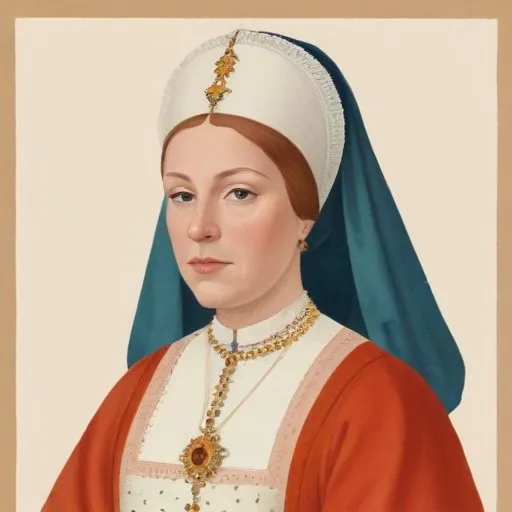
The wife of Maximilian I, Holy Roman Emperor, was a member of the powerful Sforza dynasty in Milan and played a key role in 15th-century European politics. She was a patron of the arts and a fashion icon of her time.
Bianca Maria Sforza, born on April 5, 1472, was a powerhouse of politics and royalty, holding the esteemed titles of Queen of Germany and Empress of the Holy Roman Empire through her marriage to Maximilian I. Her life was a complex web of alliances, marriages, and power struggles, yet she remains a lesser-known figure in the annals of history.
Bianca was born in Pavia, Italy, as the eldest legitimate daughter of Duke Galeazzo Maria Sforza of Milan and his second wife, Bona of Savoy. She was named after her paternal grandmother, Bianca Maria Visconti. Tragedy struck at a young age when her father was assassinated in 1476, leaving Bianca in the care of her uncle Ludovico Il Moro. Under his tutelage, Bianca's education was neglected, and she was allowed to indulge in her own interests, primarily needlework.
A series of betrothals and marriages would shape Bianca's life. At the tender age of 21 months, she was engaged to her first cousin, Duke Philibert I of Savoy. However, he died in 1482, leaving Bianca a widow at just 10 years old. She was subsequently engaged to John Corvinus, the illegitimate son of King Matthias Corvinus of Hungary, in 1485. This union was meant to secure Corvinus's inheritance of Hungary and Bohemia, but it never came to fruition due to opposition from Queen Beatrix. A potential marriage to King James IV of Scotland was also considered in 1492 but ultimately abandoned.
In 1494, Bianca married Maximilian I of Germany, a widowed king, in Hall, Tyrol. This union catapulted Bianca to the pinnacle of power, earning her the titles of Queen of Germany and Empress of the Holy Roman Empire. The marriage was a strategic move to solidify alliances and secure territories, but it also brought Bianca a sense of stability and purpose.
As queen and empress, Bianca played a crucial role in the political landscape of Europe. She was a skilled diplomat and mediator, often helping to resolve conflicts between her husband and other European monarchs. Her influence extended beyond the borders of Germany, as she played a key role in negotiations with the Kingdom of Hungary and the Duchy of Austria.
Despite her significant contributions to European politics, Bianca Maria Sforza remains a obscure figure in history. Her life was marked by a series of marriages and alliances, but she never forgot her Milanese heritage. Her legacy lies in her ability to navigate the complex web of royal politics, securing her place as a formidable queen and empress.
Bianca Maria Sforza may not be a household name, but her legacy as a powerful queen and empress continues to inspire and fascinate. Her life serves as a testament to the complex and often tumultuous world of royal politics, where alliances were forged and broken, and power was constantly shifting. Despite the challenges she faced, Bianca remained a steadfast presence, shaping the course of European history in ways both seen and unseen.

Born in 1459
First Holy Roman Emperor to rule simultaneously as King of the Romans and King of Spain, known for uniting fragmented German states and establishing the Habsburg dynasty.
Born in 1500
Ruling over a vast empire from 1519 to 1556, he was a powerful and influential leader who played a crucial role in shaping European politics and religion. He is most known for his efforts to unify Christian Europe and defend it against the Ottoman Empire.
Born in 1478
The King of Castile and ruler of Burgundy, known for his lavish spending and cultural achievements, including the construction of the Palace of Coudenberg in Brussels.
Born in 1380
Unified the Crown of Aragon, ruling over a vast territory in eastern Spain, and sponsored the voyages of Christopher Columbus, leading to the discovery of the New World.
Born in 1451
Unified the Spanish kingdoms, sponsored Christopher Columbus's voyage to the Americas, and established the Spanish Inquisition.
Born in 1487
A 16th-century Pope who commissioned Michelangelo to paint the Sistine Chapel's frescoes and was a patron of the arts, leaving a lasting impact on Renaissance art and architecture.
Born in 1452
Ruler of Milan who commissioned Leonardo da Vinci's famous painting, The Last Supper, and was a patron of the arts and architecture.
Born in 1444
The ruler of Milan from 1466 to 1476, known for his cruel and tyrannical reign, marked by numerous assassinations and brutal suppression of opposition. He was also a patron of the arts, commissioning works from famous artists like Leonardo da Vinci.